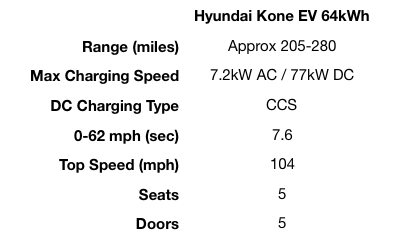



Hyundai Kona electric
2018 onwards
The Hyundai Kona was one of three EVs a I drove in 2020 when helping a friend choose a new car. It was this, the Nissan Leaf and the Tesla Model 3.
In spite of how wowed she was by the Tesla, and excited at the prospect of buying one, her final decision was to buy the Kona.
It was a decision she remained happy with.
She actually chose the top of the range Ultimate specification, which came with a whole host of features, including heads up display and ventilated seats (my favourite aspect).
Whilst I had driven several EVs before the Kona, this was the first car we drove as part of testing for new cars for Sally. We were both immediately impressed with so many aspects of the car, including the driving position and the serenity of the drive. It was a high spec car that we drove and this rather influenced the decision to buy this car.
On the Road
The well-distributed weight of the Kona EV provides a solid and confident ride. The battery is placed under the seat which means the car has a low centre of gravity and this results in reasonable driving dynamics. It's no sports car, but it is a pleasant drive. Manoeuvring the car is slow speed areas such as town centres is easy, as is parking. When pushing along on single carriageways, and entering corner swiftly, there is some body roll, but not as much as you'd normally expect from a car of this size and body style. This is a benefit of the relatively low and well distributed battery weight.
The car, like all EVs, benefits from a regenerative braking system that can be adjusted in the aggressiveness of its slowing power. As with most modern quality cars, the Kona has disc brakes all round with ABS and emergency brake assist.
Interior
The cabin provides ample leg and headroom for two six-footers up front and the seats, on my short test drive, seemed pretty good. In the back, space is a bit tighter and you wouldn't want to travel far with three adults back there. The Kona electric Ultimate we drove came standard with leather-trimmed heated and, as I've already mentioned, ventilated front seats. Whilst Sally enjoyed the heated seat, I enjoyed the ventilated aspect. I actually had the turn the degree of ventilation down during my drive, which suggests that it would have still kept me comfortable when we hit the hotter weather.
Range and Charging
Hyundai claimed, at the time - and if my memory serves me right, a range of 268 miles from the 64kWh battery in the car we tested and which Sally subsequently bought. The EV Database gives a headline 'real range' figure of 240 miles, but also suggest it has a combined (city and highway) range of 205 miles in cold weather and 280 miles in milder weather. If your mileage is going to be predominantly in towns or cities, you could see as much as 360 miles. It is probably for this reason that the Kona electric was one of the taxis we saw on a recent trip to Budapest.
It is a shame that the DC charging speed was only 77kW, especially given Hyundai's latest models have charging speeds of well over 200kW.
Verdict
Well, obviously, Sally loved the Kona; she bought it. But I really liked it to. It is a well packaged, efficient and nice to drive car. The boot isn't huge, but it's adequate for most people. In all honesty, reflecting on the car as I write this, I'm wondering if I should have bought one of these instead of my MG5.

The ranges stated in the above table are approximations based upon the combined cycles (city and main roads) in the cold and in warmer weather. These are not guarantees and they are not based upon the experience from my test drive.
You can find lots of information about electric vehicles, past and current, at http://www.ev-database.org
We need your consent to load the translations
We use a third-party service to translate the website content that may collect data about your activity. Please review the details in the privacy policy and accept the service to view the translations.
